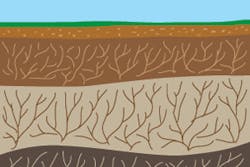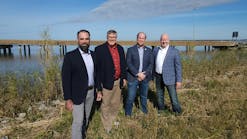Cost-Effective Erosion Control With Blankets and Mats – Part 1
Today’s tough federal and state environmental laws force both public and private developers to be much more careful in developing a construction site than in the past. National Pollutant Discharge Elimination System (NPDES) Phase II permits are required for construction activities disturbing more than 1 ac. (down from 5 ac. under NPDES Phase I), and many states now require developers to produce a formal erosion and sedimentation control (ESC) plan if they intend to disturb as little as an acre of land. Some maintain that much of today’s erosion control industry has been legislated into existence over the past few decades through USEPA and state-level department of environmental protection guidelines and regulations.
The upshot: Developers have had to become far more diligent in preventing erosion on the construction site–not just after construction is completed, but also during the construction phase itself. Once an area has been graded, a developer must move quickly to seed and then protect it from the erosive effects of wind and rain. Numerous techniques and products for controlling erosion and sedimentation, from hydomulching to hay and straw mulching to temporary erosion control blankets, have been developed. Stricter regulation has also resulted in the construction of many more channels and ditches for gathering stormwater on construction sites–be it along a highway or on a commercial or residential development–before it can do erosive damage, then safely routing it to nearby sedimentation (temporary) or detention (permanent) basins. Developers also face the problem of how best to prevent those channels and ditches themselves from eroding every time they carry a surge of stormwater—and that’s where permanent turf reinforcement mats (TRMs) have been playing a rapidly expanding role.
Not surprisingly, state departments of transportation are among the most active organizations in erosion and sedimentation control. Yet there seems to be considerable variation in philosophy and approach from state to state. We have singled out three states with varying terrains and climates—Pennsylvania, Colorado, and Texas—to examine how practices vary.
Pennsylvania: Fertile and Cost-Conscious
As Jeff Smallman, project development engineer with the Pennsylvania Department of Transportation (PennDOT) District 5 (Allentown), explains, state environmental laws require a developer, private or public, to prepare an ESC plan anytime it intends to disturb an acre or more of soil. The plan must be approved by the local county soil conservation district, to which enforcement of the state’s erosion control laws in any given county has been delegated. If less than an acre is to be disturbed, the developer must still construct standard measures to control erosion and sedimentation, but no formal plan is needed. A plan can be quite elaborate: one ESC plan for a $90 million highway extension in Easton, PA, ran 300 pages.
PennDOT works closely with local county soil conservation districts in the state to come up with effective ways to minimize erosion. According to Smallman, PennDOT currently spends about 10% of construction costs on ESC measures–and is eager to hold the line there. Only a decade or so ago, prior to the tougher new laws, Pennsylvania and many other states spent very little on ESC. County soil conservation districts, he observes, are nowhere near as cost-conscious as private and public developers; they focus mainly on preventing erosion and sedimentation rather than holding down construction costs. PennDOT is likewise environmentally sensitive and does not want to contribute any sediment to commonwealth waters. Yet it also has a responsibility, Smallman emphasizes, to spend the public’s highway-construction dollars prudently. This acute cost-consciousness permeates PennDOT’s approach to erosion control.
Concerning the protection of newly graded and seeded slopes and embankments against erosion, PennDOT’s first defense, Smallman explains, is to avoid wherever possible designing slopes steeper than 2:1 (horizontal to vertical). Steeper slopes create both slope-stability and erosion problems. He estimates that in 95% of new highway projects in recent years, the embankments and cuts constructed have slopes of 2:1 or less. In Pennsylvania and several other states, temporary erosion control blankets are stapled down only on freshly graded slopes 2:1 or steeper (in other states the guideline is for slopes 3:1 or steeper); for less steep slopes, less costly options are usually used.
For shallower slopes, the first line of defense is to construct a channel or a ditch along the top of the slope or embankment to intercept runoff about to run down the slope. Collected stormwater is then conveyed to the base of the slope via a temporary corrugated slope pipe, and from there a channel conveys the water to a sedimentation or detention basin.
In protecting newly graded slopes that are 4:1 or flatter, Smallman says, PennDOT merely seeds the slope and mulches with loose straw or hay; no plastic netting is applied. For slopes of 4:1 up to 2:1, PennDOT first seeds, then applies hay or straw mulch, and finally lays down a plastic netting over the mulch to keep it from washing or blowing away. Smallman maintains that such a cost-effective solution has worked well. Slopes steeper than 2:1 are often reinforced with geogrid, and then a temporary blanket is stapled down to the freshly seeded surface.
Where temporary erosion control blankets and permanent TRMs find their greatest application in PennDOT, Smallman explains, is in the temporary or permanent lining of stormwater channels and ditches. In designing for a two-year storm, engineers calculate the expected water velocities. For relatively low-velocity channels, the solution can be as simple as seeding with grass seed, then placing a loose straw or hay mulch on top of it; or for higher anticipated stormwater velocities, it might involve placing a plastic net over the straw or using greater protection, such as a blanket of straw, jute, coconut fiber (coir), or excelsior. After several months, the new stand of grass that has sprouted up in the channel will provide permanent erosion protection. If anticipated channel velocities are higher than vegetation alone can withstand, PennDOT resorts to a more costly synthetic permanent TRM. Smallman is enthusiastic about the cost-saving potential of using permanent TRMs in channels compared to other alternatives. “A synthetic mat is much cheaper than using either riprap or concrete to line a channel. It is just a matter of rolling out the mat and pinning it down.” However, where anticipated velocities are too high even for reinforced turf–greater than 9–10 feet per second—the channel is lined with riprap, and where there is concern the runoff might gouge out a sinkhole, PennDOT uses concrete channel lining.
Editor’s note: This article appeared in a previous issue.






